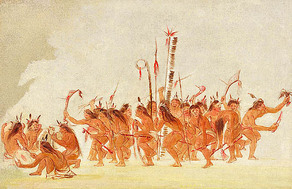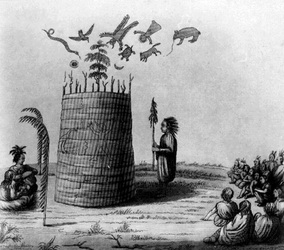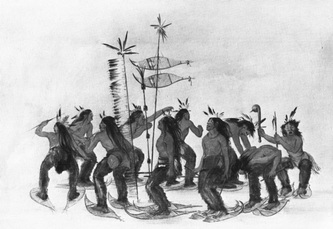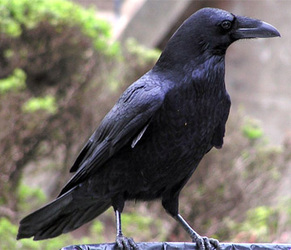Social Organization
The subarctic peoples were divided into semi-nomadic groups or bands. Since they had no formal tribe organization all men and women had right to make decisions that could affect the band. If a family or a single person was disagreeing with the decision, they were allowed to go to another band or could act on their/its own for a small period of time. Band worked together to hunt and to survive. When several bands worked together they were called regional bands. Regional bands got together for annual festivities and ceremonies. Also if the food supply got low the bands got together to hunt. Leaders of the band took control because they were good at it or they had great wisdom or they had spiritual powers. The leaders controlled the trading, war and communal hunting. They had only little wars time to time but never a huge war.
Ceremonies
They created religious dances, which were based on the song they learned from the journey to the heaven. Medicine peoples also known as 'shaman' conducted a ceremony called 'shaking tent'. The ceremony was taken so that they conjured up spirits of people or animals for curing or prophecy in a special teepee. Another way was that shaman would take the ceremony under a blanket or dress in a special way to signal their office. They cured the sick by singing or use magic to extract the illness. Shamans could use thier power to heal and use it to benefit others or they could use it to harm and cause evil.
Religion
In the subarctic myth people believed that the first people to become powerful was 'the hero'. In their case the power was combined with knowledge and when they say to be powerful, it also meant to knowledge. The hero expressed the personal knowledge and self reliance as a survival skill. He could also out smart evil medicine people and could escape danger, which made the world to be easier place to live. The heroes were trickster figures and they were Nanabush and Wisahkecahk. For some other people they believed in animal spirits and spirit beings and Bushmen (wild Indians with supernatural attributes) and their hero was a raven. Children also learned the importance of good relations with spirits of animals. Every tribe had a hero or a trickster of some sort.




